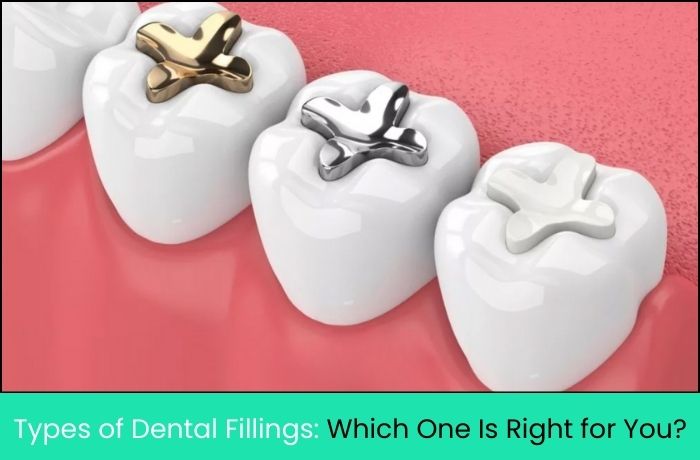Dental fillings are one of the most common treatments to restore teeth affected by cavities or decay. But with so many types of fillings available, how do you know which one is best for your situation? In this blog, we’ll look at the different types dental of fillings, what they’re made of, their advantages and disadvantages, and how to choose the right one for your teeth.
Why Do You Need a Dental Filling?
When a tooth has a cavity, it means that part of the tooth has decayed. If left untreated, this decay can spread deeper into the tooth and cause pain, infection or even tooth loss. Dental fillings are used to stop this decay by sealing the damaged area and preventing bacteria from causing further damage.
Without a filling, the damage could get worse, leading to more serious problems that may require treatment such as a root canal or even tooth extraction. A filling can help save your tooth and restore its normal function.
Common Types of Dental Fillings
Dental fillings are made from a variety of materials, each with its own advantages and disadvantages. Let’s take a closer look at the most commonly used types:
1. Amalgam (silver) fillings
Amalgam fillings have been used for more than a century. They’re made from a mixture of metals, including mercury, silver, tin and copper. These fillings are strong and durable, making them ideal for the back teeth where there is a lot of chewing pressure.
Pros:
Long-lasting and can withstand the force of chewing.
Less expensive than other options.
Cons:
Visible due to their silver colour.
Some people may be concerned about the mercury content, although research shows it’s safe.
Best for:
Back teeth (molars) where strength is important and appearance is less of a concern.
2. Composite Fillings (Tooth-Colored Fillings)
Composite fillings are made from a resin material that can be coloured to match your natural teeth, so they blend in well. They are often used for front teeth or other visible areas.
Pros:
Blends in with the natural colour of your teeth.
Bonds well to the tooth structure, which can help support the rest of the tooth.
Cons:
Not as strong as amalgam, so can wear down more quickly in areas where there’s a lot of pressure.
Usually more expensive than amalgam.
Best for:
Front teeth or visible areas where appearance is important.
3. Ceramic Fillings (Porcelain Fillings)
Ceramic fillings are made from porcelain and are durable and stain-resistant. They can be made in a laboratory to fit your tooth perfectly.
Pros:
Match the color of your teeth for a natural look.
Stain-resistant, which helps maintain their appearance over time.
Cons:
Can be more expensive than other types of fillings.
The material is more brittle, so larger fillings may be more prone to cracking.
Best for:
People who want a long-lasting, tooth-colored filling for visible teeth.
4. Gold Fillings
Gold fillings are made from a gold alloy, and although they’re less common these days, they’re still a great option for people who want a very durable material.
Pros:
Extremely durable and can last for many years.
Many people like the look of gold for its uniqueness.
Cons:
Very expensive compared to other materials.
The gold color is obvious and may not be aesthetically pleasing to some.
Best for:
Back teeth are for people who value strength and durability over appearance.
5. Glass Ionomer Fillings
Glass ionomer fillings are made from a material that releases fluoride, which can help protect your teeth from further decay. However, they’re not as strong as other filling materials.
Pros:
Releases fluoride, helping to protect teeth from future decay.
A good option for children’s teeth or areas that don’t require a lot of chewing.
Cons:
Weaker than other fillings, so may wear down more quickly.
Not as tooth-colored as composite fillings.
Best for:
Children’s teeth or for filling cavities near the gum line.
Factors to Consider When Choosing a Dental Filling
Choosing the right filling depends on several factors, including the location of the cavity, the size of the cavity, your dental habits, and your budget.
- Location of the cavity: If the cavity is in a visible area, you may want a filling that matches your tooth color, such as composite or ceramic. For back teeth, where durability is more important, amalgam or gold may be a better choice.
- The size of the cavity: Larger cavities may require stronger materials, such as amalgam or gold, because they can withstand more pressure.
- Cost: Some materials, such as gold or ceramics, are more expensive. If cost is an issue, amalgam or composite fillings may be a better choice.
- Durability: If you want a long-lasting filling that doesn’t need to be replaced often, gold or ceramic may be the way to go.
Signs You Need to Replace Your Dental Filling
Fillings don’t last forever and there are signs that it’s time for a replacement. These include
- Pain when chewing or biting.
- Noticing cracks or chips in the filling.
- If the filling is loose or has fallen out.
- Discoloration or visible wear around the filling.
If you experience any of these symptoms, it’s important to see your dentist to prevent further damage to your tooth.
Understanding the different types of dental fillings and their benefits can help you make an informed decision about your dental health. Whether you need a durable filling for your back teeth or an aesthetically pleasing option for your front teeth, there’s a filling material to suit your needs.
Looking for advice on the best dental filling for your needs? Visit Dr.Samidha Patil, an experienced dentist in Kharadi at The Team Dental Clinic, to discuss your options and ensure your teeth stay healthy and strong.

